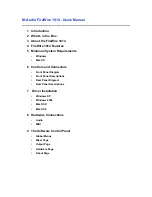
HCT User Guide
page 33
Copyright © 2001 HutchColor, LLC
User_Guide_43.docx 2/10/19
Frequently-asked questions
Older reference file date
Q: The HCT website says "Actual measurements are made as near as possible to the shipping
date." but my brand-new HCT has a reference file dated several years ago. Did I receive an old
target by mistake? How will this affect the quality of my profiles?
A: HCT targets are measured as near as possible to the date when they are shipped TO THE
WHOLESALER, but we cannot control how long a target will sit in the wholesaler's inventory.
Recent tests on a selection of control targets that were NOT REFRIGERATED produced a PEAK
(worst case) error after more than three years of LESS THAN 1.0 DELTA-E(ab) from the original
reference file. This is well within the tolerances of a good spectrophotometer, and approximates
the error produced by reading the same target twice on the same day.
Although these tests indicate a very long shelf life, unshipped HCT targets are kept in
refrigerated storage until they are shipped.
Does my software support the HCT?
Q: I have (or am thinking of buying) software called (insert your software name here). Does it
support the HCT target?
A: If you do not see the software listed on the HCT website, it may support the HCT but we may
not yet be aware of this. Please ask the software manufacturer directly, and if it does, please let
us know and we will up-date the HCT website accordingly, after testing the software.
Grainy or noisy scans
Q: Upon enlarging the HCT target scan I notice a lot of grain in the patches. Should I attempt to
smooth out the grain before creating the profile?
A: NO! Any grain you see is a normal product of film emulsions and/or the scanner, and is actually
valuable in helping an 8-bit per channel scanner "see" more that the normal 256 tone levels.
Good profiling software will integrate (average) the grainy pixels to produce an RGB value with
better than 8 bit precision. If you try to smooth the HCT target scan (or even a live original) for
example with a noise filter, you will actually be reducing the precision of the profile.
MonacoPROFILER rejects the target scan
Q: MonacoPROFILER tells me there is a problem with the target scan and refuses to build a profile.
I have scanned and cropped the HCT correctly. What's going on?
A: This is the result of over-cautious software combined with a slight change in the target design.
Monaco software is pre-programmed to reject any target scan whose gray scale RGB values
are outside a certain tolerance. In the latest HCT design, some of the gray-scale patches have
been altered to be slightly pastel-colored, which improves profile accuracy in near-neutrals, but
this puts the patches over the RGB tolerance limit expected by Monaco.
The Windows solution is to modify the "neutral ramp bumps error maximum:" value.
The Macintosh solution is to alter the "maximum initial
∆
E error maximum:" value.
You can get full instructions on how to do this from Monaco support, but here are some
suggestions. Note that these instructions MAY NOT BE ACCURATE, and may not work, or
remain necessary, as the software evolves.






































